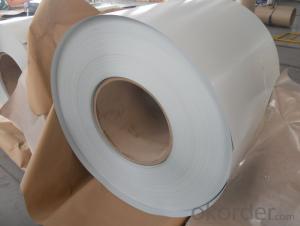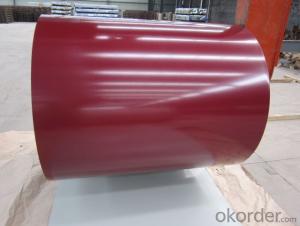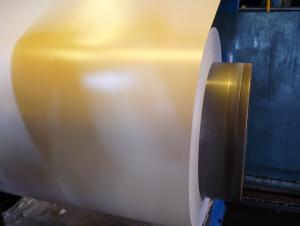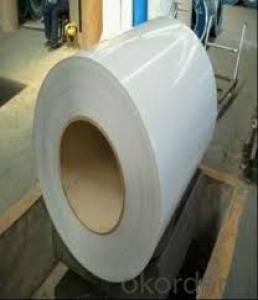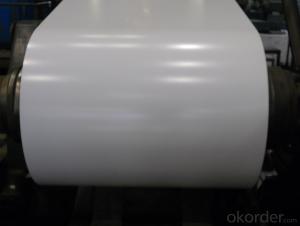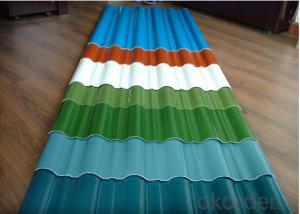PRE- PAINTED GALVANIZED STEEL COILS
- Loading Port:
- Shanghai
- Payment Terms:
- TT OR LC
- Min Order Qty:
- 50 m.t.
- Supply Capability:
- 5000 m.t./month
OKorder Service Pledge
OKorder Financial Service
You Might Also Like
PRE-PAINTED GALVANIZED STEEL COILS
ZINC COATING:G40
TOP COATING:5 MIC EPOXY+20 MIC PE, PROTECTION FILM
BACK COATING: 7 MIC EPOXY GREY
WEIGHT PER COIL:2-3 TONS COLOUR: RAL 9010 PURE WHITE
STANDARD:JIS G3312,CGCC
0.40mm(TCT-P)*1219mm*C |
0.50mm(TCT-P)*1220mm*C |
0.45mm(TCT-P)*1220mm*C |
0.60mm(TCT-P)*1219mm*C |
Package:covered with waterproof-paper,strapped by strips. Standard seaworthy export package:4 eye bands and 4 circumferential bands in steel, galvanized metal fluted rings on inner and outer edges, galvanized metal & waterproof paper wall protection disk, galvanized metal & waterproof paper around circumference and bore protection.
Electial Appliance:refrigetator.washer,switch cabinet,etc
Furniture:central heating slice,lampshade,etc
Inside:doo,doorcase,light steel roof structure,vent gutter,etc
Electial Appliance:refrigetator.washer,switch cabinet,etc
Furniture:central heating slice,lampshade,etc
Other :clapboard,container, writing panel,garbage can,timekeeper,etc
- Q: What is a steel coil?
- A steel coil is a coiled sheet of steel that is typically used in various industries for manufacturing purposes. It is a continuous length of steel that has been wound into a coil shape, making it easier to transport and store. Steel coils are commonly used in the automotive, construction, and appliance industries, among others, for applications such as making metal parts, forming structures, and producing steel components.
- Q: What are the common applications of stainless steel coils?
- Stainless steel coils have a wide range of applications due to their unique properties and characteristics. Some of the most common applications of stainless steel coils include: 1. Automotive industry: Stainless steel coils are widely used in the automotive industry for various components such as exhaust systems, mufflers, and catalytic converters. The corrosion resistance and durability of stainless steel make it an ideal choice for these applications. 2. Construction industry: Stainless steel coils are extensively used in the construction industry for structural elements, roofing, cladding, and facades. Its high strength, resistance to corrosion, and aesthetic appeal make stainless steel a popular choice for architectural projects. 3. Kitchen appliances: Stainless steel coils are commonly used in the manufacturing of kitchen appliances such as refrigerators, stoves, ovens, and dishwashers. The easy cleanability, resistance to heat and stains, and hygienic properties of stainless steel make it a preferred material for these applications. 4. Food processing industry: Stainless steel coils are widely used in the food processing industry for equipment such as tanks, pipes, and conveyor systems. The corrosion resistance and easy cleanability of stainless steel ensure the integrity and hygiene of food products. 5. Medical industry: Stainless steel coils find extensive use in the medical industry for various applications such as medical devices, surgical instruments, and implants. The biocompatibility, strength, and resistance to corrosion make stainless steel an ideal material for these critical healthcare applications. 6. Energy sector: Stainless steel coils are used in the energy sector for applications such as heat exchangers, boilers, and pipelines. The high-temperature resistance, excellent mechanical properties, and corrosion resistance of stainless steel make it suitable for these demanding applications. 7. Chemical industry: Stainless steel coils are employed in the chemical industry for storage tanks, piping systems, and reactors. The corrosion resistance and ability to withstand high temperatures and aggressive chemicals make stainless steel coils a reliable choice for handling various chemical substances. 8. Manufacturing industry: Stainless steel coils are used in a wide range of manufacturing processes such as stamping, forming, and fabrication. The versatility, durability, and ease of machining of stainless steel make it a popular choice for various industrial applications. Overall, the common applications of stainless steel coils are vast and varied, thanks to their exceptional properties like corrosion resistance, strength, durability, and aesthetic appeal.
- Q: What are the safety precautions to be taken while handling steel coils?
- When handling steel coils, several safety precautions should be followed to minimize accidents and injuries. Some of the key safety measures include: 1. Personal Protective Equipment (PPE): Wearing appropriate PPE, such as safety gloves, steel-toed boots, and protective eyewear, is essential to protect against potential hazards like cuts, impacts, and eye injuries. 2. Proper Lifting Techniques: Using correct lifting techniques, such as bending the knees and using leg muscles instead of the back, helps prevent strains and back injuries. It is also important to seek assistance or use lifting equipment when dealing with heavy coils. 3. Secure Storage and Handling: Coils should be stored in a stable and secure manner, ensuring they are properly stacked and restrained to prevent them from tipping or falling. Adequate space should be provided between stacks to allow safe movement around them. 4. Inspection and Maintenance: Regularly inspecting coils for any defects, such as sharp edges, loose straps, or damaged packaging, helps prevent accidents. Damaged coils should be repaired or replaced, and any loose materials or debris should be removed. 5. Proper Handling Equipment: Using appropriate handling equipment, such as coil lifters or forklifts, ensures safe transport and manipulation of steel coils. Operators should be trained in the correct use of such equipment to minimize the risk of accidents. 6. Communication and Signage: Clear communication among workers and proper signage indicating potential hazards, load capacities, and designated walkways can help prevent accidents and ensure a safe working environment. By following these safety precautions, the risk of accidents, injuries, and damage associated with handling steel coils can be significantly reduced.
- Q: why does steel have a density range when other metals do not?
- Steel is not a pure element it is an alloy. Steel is primarily iron but it has many elements blended in that change it's density including carbon,silicon, nickel, chrome, etc. Aluminum and copper , magnesium and so forth can be the pure element or they can be alloys too. If they are alloys, then their densities vary also
- Q: Does anyone know the lyrics to steel driving man by Dailey and Vincent. I would really appreciate it
- I okorder /
- Q: How are steel coils used in the manufacturing of industrial mixers?
- Steel coils are used in the manufacturing of industrial mixers as they provide a strong and durable structure for the mixer body. The coils are shaped and welded to create the necessary components, such as the mixing chamber and blade supports. This ensures that the mixer can withstand the high forces and vibrations involved in mixing large quantities of materials in industrial applications.
- Q: What is the process for uncoiling and recoiling steel coils?
- The process for uncoiling and recoiling steel coils involves various steps. Firstly, the steel coil is securely placed on a mandrel or a coil car. Next, the coil is unfastened or cut to release the bands holding it together. Then, a suitable uncoiling machine is used to gradually unwind the coil, ensuring it is done in a controlled manner to prevent damage or accidents. Once the desired length of steel is unwound, it can be cut or sheared to the required size. To recoil the steel, it is fed through a recoiling machine that winds it back onto a new core or mandrel. Proper tension is applied during this process to ensure a tightly wound coil. Finally, the recoiled steel coil is secured with bands or straps for transportation or storage purposes.
- Q: What are the common storage defects in steel coils?
- Steel coils can suffer from various storage defects, including staining or discoloration, rust or corrosion, coil deformation, surface damage, edge damage, coil slippage, contamination, and coil nesting. These defects can negatively impact the appearance, quality, usability, and safety of the steel. To prevent these defects, it is essential to implement proper handling, storage, and protection measures. This involves storing the steel coils in a dry and well-ventilated area, away from moisture and chemicals. Additionally, appropriate stacking and support structures should be used to prevent deformation and bending. To avoid mishandling and transport damage, it is important to stack and handle the coils correctly. Adequate protection against impacts and contaminants should be provided to prevent surface scratches, dents, and abrasions, as well as edge damage. It is crucial to ensure that the edges of the coils are properly protected and secured during storage to maintain their usability and safety. Furthermore, to prevent coil slippage and potential harm to personnel or equipment, the steel coils should be securely stored and stacked. To avoid contamination, the coils should be kept away from substances like dirt, oil, grease, and chemicals. Regular inspections and maintenance should be conducted to identify and address any potential defects or issues promptly. Overall, by implementing these proper handling, storage, and protection measures, the occurrence of these common storage defects in steel coils can be minimized, ensuring the appearance, quality, usability, and safety of the steel.
- Q: I just want regular steel, not stainless steel.
- If it rusts, magnetic, hard, heavy with high melting point I reckon yourve found mild steel.
- Q: I am searching for an online article which discusses any aspect of the use of austenitic stainless steels. I was just wondering if anyone could help me find one. No sales articles. Thank you!
- *Austenitic, okorder
Send your message to us
PRE- PAINTED GALVANIZED STEEL COILS
- Loading Port:
- Shanghai
- Payment Terms:
- TT OR LC
- Min Order Qty:
- 50 m.t.
- Supply Capability:
- 5000 m.t./month
OKorder Service Pledge
OKorder Financial Service
Similar products
Hot products
Hot Searches
Related keywords
